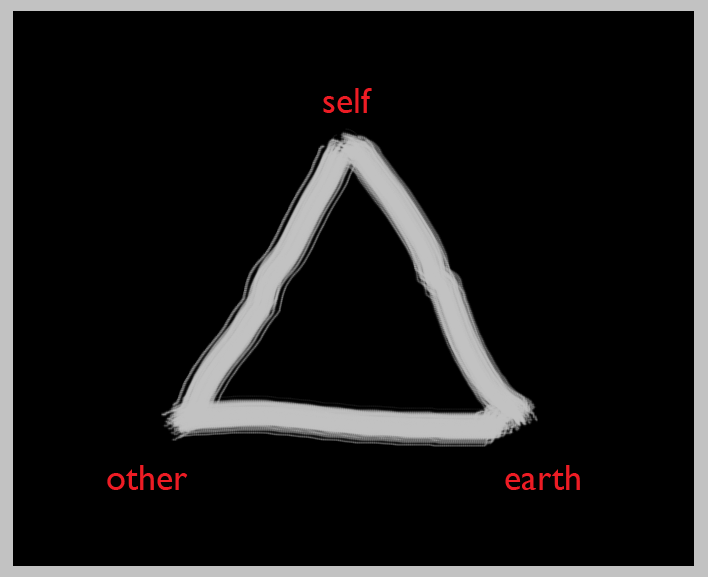
The Triangle of Relationship—
On the road in the Northwest of America.

The Triangle of Relationship—
On the road in the Northwest of America.
On the Triangle of Relationship . . .
The strength of the triangle of relationship, I find, is that it
necessarily lifts us out of the isolation of the linear,
fragmentary style of thinking so characteristic of Western
culture. The basic idea is that, for every thought, every action,
every resource or artifact, there is always at least three sides
which coexist in a movement of relational resonance which is
indivisible. As with a single singing voice in a large stone structure
like a tunnel or cathedral, there is the sound of the voice as
it appears to the singer him- or herself, but also the sound
of the voice as it appears to others—others which are either
imagined or real—who listen in the same space. And finally,
of course, there is the acoustic space itself, the wider context
of what for the singer is the whole world, both literally and in
the ritual sense. Thus, we move naturally and easily from the
top of the triangle, me, to others (we), and to the world or
Earth (the wider context) and back again. (Notice also that
this movement occurs both one-at-a-time (melody), and
all-at-once (chords), a feature very unlike visual mirrors,
but distinctive to relational resonance as a whole.)With this image in mind, it is easy to see the nature of isolation
and fragmentation. Think of the same singer, but now in a space
completely devoid of resonance. Musicians find such spaces
deeply disturbing. "There's no echo!" they say. They call such
spaces 'dry' or 'dead.' In other words, the room or hall gives
nothing back to them. So, it comes as no surprise that, without
the natural sustaining resonance of echo, which both gives
energy to the sound and makes it possible to blend and tune
with oneself and others, we very quickly stop singing
altogether.Now, if we go one step further and generalize this movement
of resonance and think not just of sound but also relationship
in terms of meaning and responsibility, we have, I think, a strong
model of ethical awareness. Here we have the image not of
sound, but a woven fabric. I, or you—the self, that is— pick up
a strand—any strand, it makes no difference—and simply follow
it to its source. This naturally reveals others connected to the
strand, as well as how the strand is woven into the fabric of
the larger whole. Take coffee, for instance. In isolation, coffee
is just a savory, pleasant, highly addictive stimulant for which
we as users naturally wish to pay the lowest possible price. But
if we begin with the relationship triangle, a far richer story is
revealed to us as we follow the highlighted thread of a single
pack of coffee. It leads us to those who market, distribute,
process and most especially, actually grow and harvest the
beans. Ultimately, we are led, as always, to the wider ecological
context which sustains both the growers and the coffee
plants themselves.If we follow this path of relationship, notice first that there is
no fundamental difference between the ethical and environmental
dimensions of awareness. They are but two inseparable aspects
of the same movement, one which emphasizes responsibility,
and the other which emphasizes understanding. Second, notice
that in the current era, coming as we all do, including myself,
from a state of isolation and fragmentation, the more consistently
and energetically we pursue the thread, regardless of where it
leads us, we are unavoidably going to be in for some shocks and
highly disturbing information. The sweat shops and child labor
behind my favorite running shoes; the half-lives of all the toxins
found in their soles. The flame retardants in the laptop I love and
depend on turning up in the breast milk of young mothers in the
far North; or a kid in India, or China, or Africa working barefoot
atop a mountain of electronic waste, eking out a living by strip
ping away the equally toxic metals of the same computer once
I'm forced to throw it away. Or, coming back to our first example,
the coffee farmer in the high-country of Ethiopia who explains that
he gets only 3 cents for each kilo of green beans he produces,
and looks straight into the lens of the camera as he tells us
that he needs at least 8 or 10 cents just to survive.So one sees that the beauty and the strength of the triangle
of relationship, just as with the musician with whom we began
in the natural world of relational resonance, is that both harmony
and disharmony are necessarily revealed. Both the good and the
bad, one can't have one without the other. This is a fact. And
perhaps this is why the ethical awareness of the compassionate
mind has evolved out of the inherently self-destructive isolation
of the brutish brain. Think of it. Where does this intelligence
come from? Simply our genetic structure? Or from some much
deeper and more subtle source? As with all really fundamental
questions of existence, we find, I think, as we follow the triangle
of relationship far enough that we are led to a point where we can
only say with the honesty a small child demands,"I don't know."
For here the known world ends, and the uncharted land of the
spiritual wilderness begins.